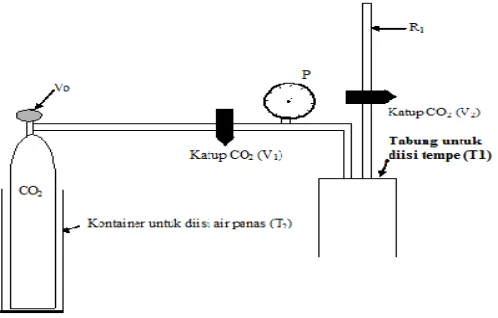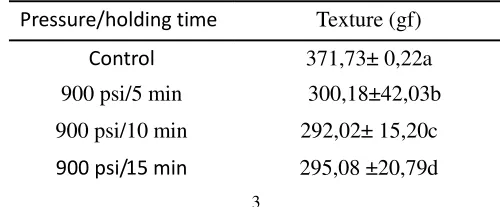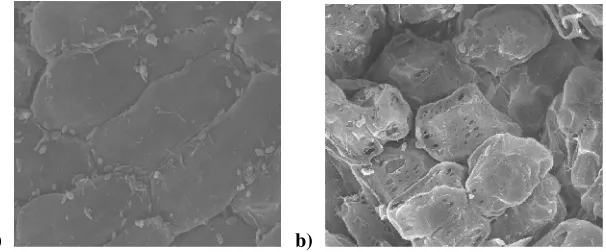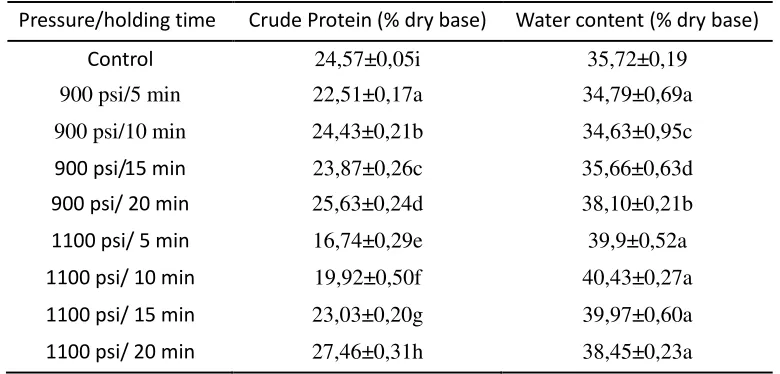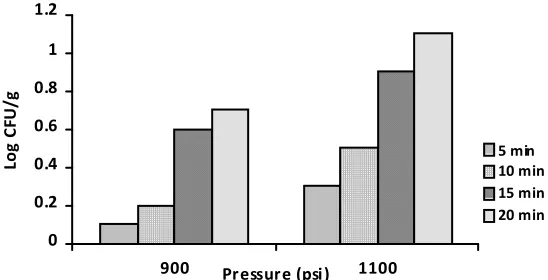!"#!
$ %
& ' ! " $ %
() * +) ! ,
) * )
"
-. - , /&" &' 0
! !
) * ) & '! .
) * )
' ' 1 2
" # " #
$ !
%&
3 , 2 4 ,
" # ' ! ( %
$ !
)
) * )
56 - , 6
! !
) * 7) '! .
13th ASEAN Food Conference, 9-11 September 2013, Singapore Meeting Future Food Demands: Security & Sustainability
1
The Physical, Chemical and Microbiological Quality of Tempe Treated with
High Pressure of Carbon dioxide
Maria E Kustyawati1,*, Filli Pratama1, Daniel Saputra2, Agus Wijaya3
1Department of Agricultural Product Technology, University of Lampung, Bandar Lampung 34155, Indonesia
2
Faculty of Agriculture, University of Sriwijaya, Palembang, Indonesia * Corresponding author: [email protected]
AbstractThe objective of this research was to analyze the physical, chemical, and microbiological quality of tempe treated with CO2 under 900 psi and 1100 psi. The treatment was designed as Randomized
Completely Block Design with two factors as treatments and each treatment was repeated three times. The first factor was the pressure under 1100 psi and 900 psi, and the second factor was holding time for 5, 10, 15, and 20 minutes. The physical quality (texture), chemical quality (water content and protein content) and reduction number of microbial loads were determined in control and treated tempe. The result showed that at the different pressure, holding time and combination of both of the treatments were significantly affected the texture, protein and water content of tempe (P<0.05). Tempe treated with CO2under 1100 psi for 5 minutes
had the highest hardness (314,73 gf) and water content (39,9%), but the lowest protein content (16,74%). The reduction number of microbial load was 1 log cycle and less than 1 log cycle in tempe treated with CO2
undert 1100 psi and 900psi for 20 minutes, respectively.
Keywords:High pressure CO2, tempe, physical, chemical, microbiological.
1. Introduction
Tempe, a fermented food originated from Indonesia, are made from cooked soybeans and fermented by Rhizopus oligosporus. Tempe is of remarkable interest due to its freshness quality and has superior nutrition. Tempe is not consumed in raw but consumer acceptability on tempe is greatly determined on the freshness of tempe. The fresh tempe describes as having white moldy color, compact and sliseable texture of a cake like, mushroomy aroma, and beany flavor. Beside its superiority in nutrition, tempe is perishable food. Fresh tempe is only stand for 48 hours at room temperature[1]. Methods for extending the storage time of fresh tempe have been sought by tempe manufacturers. Application of heat on tempe produced the cooked tempe with changing the freshness of tempe. In addition, loss of fresh taste and texture occurred at refrigerated as well as freezed storage of tempe [2]. At the same time there is increasing demand for minimally process and fresh-tasting foods. Therefore, an advanced in technology that cause least deterioration in product quality is required. Study on the processing of tempe with high pressure carbon dioxide (CO2) has not yet been done. One of the interesting properties of CO2is that its critical point can be
reached at relatively low temperature and pressure values (31.1ºC and 75 bar/ 7.4 MPa/1073 psi) which can be applied for mild heat food processing[3]. At the supercritical phase CO2exhibits both
gas-like transport characteristics and liquid-like solvent properties, which makes them useful for reactions and separations[4]. The properties of supercritical CO2can be controlled by manipulation
of the temperature and pressure. Near the critical point, small changes in temperature or pressure lead to significant changes in the density and density-dependent solvent properties such as solubility parameter, the partition coefficient and the dielectric constant[5]. Beside these interesting physical properties, specific interest in CO2 is magnified by its perceived green properties as it is relatively
non-toxic, relatively inert, and non-residual left. The objective of this research was to analyze the changes in texture, chemical contents, and microbial reduction of tempe treated with high pressure CO2at 1100 psi and 900 psi.
13th ASEAN Food Conference, 9-11 September 2013, Singapore Meeting Future Food Demands: Security & Sustainability
2
Tempe used in this experiment was obtained from tempe producer in Palembang. The materials used were gas CO2, chemicals for analysis, Plate Count agar (PCA) for bacterial growth, and mold
extract agar (MEA, Difco) for mold growth medium.
2.1. High pressure carbondioxide (HPCD) treatment.
The design of the CO2apparatus is shown in Figure 1. The system is equipped with a stainless steel
chamber, CO2gas tank, and container with hot water to control the pressure. The CO2gas reservoir
tank is regulated with a temperature-controlled heater to achieve the pressure required e.i, the supercritical phase (scCO2) was at the condition of 7,6 Mpa (1100 psi) and 45oC, and the liquid
phase (lqCO2) was at the condition of 6,2 Mpa (900 psi) and 25oC. Tempe, a 29-30 g, cylindrical
long shape 10x2x2 cm3, were placed into a stainless steel chamber. Tempe was then pressurized with CO2 at 900 psi and 1100psi by adjusting the temperature of the CO2 in the system.
Approximately 2 min was needed to achieve a pressure of 1100 psi. When the required pressures were reached, the process was hold for 5, 10, 15, and 20 min. Following was the decompression time which was approximately 2 min to reach the pressure at an ambient temperature.
Figure 1. The diagram of CO2instrument used in the study.
2.2. Analysis
2.2.1. Microbial analysis
Tempe (5g) was homogenized using Stomacher Bag and the macerate was serially diluted with peptone water. Total viable counts were determined as duplicate spread plate of 1 mL ofdiluted sample in Plate Count agar (Difco). Plates were incubated for 24 h at 32o. The counts were reported as log CFU/g of tempe. Reduction number was calculated as the difference between the number of viable cell before the treatment and after the treatment in log.
2.2.2. Physical analysis
13th ASEAN Food Conference, 9-11 September 2013, Singapore Meeting Future Food Demands: Security & Sustainability
3
and 10.000 magnifications, with an acceleration potential of 20 kV.
2.2.3. Chemical analysis
The proximate analysis of the treated and non-treated tempe were done including the protein content and moisture content followed the method of AOAC [6].
2.3. Experimental design and data analysis
The experiment was designed as Randomized Completely Block Design with two factors of high pressure as treatment and each treatment was repeated three times. The first factor was high pressure CO2 under 1100 psi (7,6 MPa) and 900 psi (6,2 MPa), and the second factor was holding time at 5, 10, 15, and 20 minutes. One way ANOVA was applied to all the data and the significant different results were analyzed further using Duncan Multiple Range Test (DMRT).
3. Result and discussion
3.1. Texture analysis
Texture is commonly related to physical properties such as firmness, hardness and viscosity measurements. Based on ANOVA and the Duncan (DMRT) Test, treatment with high pressure of CO2, the duration of treatment in minutes, and the combination of both of treatment and duration of
the treatment significantly changed the texture of tempe (P≥0,05) (Table 2). Treatment under 1100 psi for 20 minutes decreased the hardness of texture tempe (272,88 gf ± 32,54). Another study reported the textural changes of carrot dried with CO2 under 100-550 MPa for 20 minutes[7]. The
result of our study suggested that the high pressure might rupture the bean’s cell wall which then
decreased the cellular turgor and cell wall integrity. In addition, the microstructure analysis (Figure 2)showed that the bean’s cell wall was shrinkage that could be as a result of pressure released, but it retained the circularity of the cell. At the pressure of 900 psi CO2was thought to diffuse into the
bean’s cells and the water present in the cell was expected to be dissolved into. Upon depressurization, the CO2 was expelled from the bean’s cell andmaintain the cell volume, since the
CO2was able to occupy volume that was originally occupied by water. This explained the ability of
bean’s cells to retain their circularity well. Yet, depressurization caused the shrinkage of the bean’s
cell wall resulting in the decrease in hardness. Study done by Son and Lee [8] reported that pasteurization of kimchi with high pressure CO2caused the texture became firmer. This was not in
agreement with our study because high pressure when applied to the vegetables produced the cell wall firmer than the raw one[9].
Tabel 1. Texture of tempe treated with CO2under 1100 psi and 900 psi for different holding time.
Pressure/holding time Texture (gf)
Control 371,73± 0,22a
900 psi/5 min 300,18±42,03b
900 psi/10 min 292,02± 15,20c
13th ASEAN Food Conference, 9-11 September 2013, Singapore Meeting Future Food Demands: Security & Sustainability
4
900 psi/ 20 min 293,83 ±29,99e
1100 psi/ 5 min 314,73± 56,12f
1100 psi/ 10 min 302,00 ±46,03g
1100 psi/ 15 min 291,52 ±27,50h
1100 psi/ 20 min 272,88± 32,54i
Means followed by the same letter within a column are not significantly different atP<.05.
a) b)
Figure 2. Scanning electron microscope of the surface tempe:a) surface tempe without treatment, b) surface tempe treated with CO2under 900 psi (6,2 MPa) for 5 min.
3.2. Chemical analysis
3.2.1. Protein content
Based on ANOVA and the Duncan (DMRT) Test, the treatment of high pressure of CO2, the
duration of the treatment, and the combination of both of them significantly changed the protein content (P≥0,05). The treatment of CO2under 1100psi for 5 minutes provided the lowest protein in
tempe, but the protein content was high on tempe treated for 20 minutes at 900 psi or 1100 psi. Another study reported that supercritical CO2 can stabilize the secondary structure as a result of
solvent effect[10]. VanHekkenet al [11] reported that application of milk with high pressure CO2
under 5,52 MPa resulted in precipitation of casein. The result of our study suggested that during the application of high pressure under 1100 psi (7,6 Mpa), CO2which posses high solubility power may
diffuse into the protein and the tertiary structure which is held by hydrophobic interaction may be disrupted and dissolved into CO2. In addition, because the dielectric constant of supercritical CO2is
weak, it is immiscible with organic solvent such protein molecules, resulting in the precipitation. When the pressure was released, the CO2 reformed and left precipitated protein. The decrease of
protein in our study may as a result of the denaturation and the precipitation. Moreover, the high water content in tempe may contribute to the denaturation and the protein precipitation, because CO2dissolved in the aqueous phase of the tempe resulting in a decrease in the pH which remained
in the tempe when CO2was dissipated out during depressurize. The low pH causes precipitation of
protein tempe. Therefore, it could be suggested that high pressure treatment applied in our study may cause denaturation and a reversible changes of protein, as the secondary structure of protein is disrupted at pressure of≥ 300 MPa[12],[13].
13th ASEAN Food Conference, 9-11 September 2013, Singapore Meeting Future Food Demands: Security & Sustainability
5
Based on ANOVA and the Duncan (DMRT) Test, the treatment of high pressure of CO2, the
duration of the treatment, and the combination of both of them significantly changed the water content of tempe (P≥0,05). The water contents in tempe treated with CO2 under 1100 psi were higher than that of treated under 900 psi CO2(Table 2). Another study reported that water was more
soluble in supercritical CO2 than in liquid CO2 [14]. The high pressure of CO2 processing is
actually involved an exothermic reaction [4]. The result of our study suggested that when 1100 psi of CO2 was applied, the high compressibility is used to absorb excess heat evolved in the reaction
and the vapor pressure surrounding the system was very dense. Upon the pressure released the CO2
reformed and the vapor state was changed to liquid state, resulting in an increased of RH. When RH in the atmosphere is high, tempe would absorb more water, and as a result in high water content. Water content in tempe treated with CO2 under 1100 psi was higher than that of under 900 psi,
because the temperature, pressure and subsequently vapor pressure were higher.
Tabel 2. Protein and water content of tempe treated with CO2under 1100 psi and 900 psi for different
holding time.
Pressure/holding time Crude Protein (% dry base) Water content (% dry base)
Control 24,57±0,05i 35,72±0,19
Means followed by the same letter within a column are not significantly different atP< .05.
3.2.3. Microbial analysis
Figure 3 showed that the reduction number of treated tempe with CO2under 1100 psi for 20 minutes
was 1 log, while the reduction number was less than 1 log on treated tempe under 900 psi. Another study reported that CO2 under 75-110 bar (1087-1595 psi) reduced the microbial load of tomato
paste less than 1 log [15]. Werner and Hotchkiss [16] reported that CO2under 20,7 MPa (3002 psi)
reduced the microbial load of milk by 5,36 log. Those differences in the reduction number of microbial loads may be due to the properties of the food constituents which influenced the rate transport of CO2[18] . The result of our study suggested that the destruction of microorganisms may
be as a result of acidification of the tempe being treated. The acidification occurs as a result of CO2
interaction with water in the tempe, this interaction ultimately results in the generation of H2CO3.
H2CO3exists in equilibrium with HCO-3, this equilibrium is responsible for the release of protons in
the bacterial environment, thus decreasing pH [17]. Low pH then can induce structural changes in the bacterial membrane cell which will increase the permeability of the membrane to CO2. CO2then
13th ASEAN Food Conference, 9-11 September 2013, Singapore Meeting Future Food Demands: Security & Sustainability
6
resulting in the death of the bacterial cell.
0
Figure 3. Reduction number (log CFU/g) of microbial loads in tempe treated with CO2under 900 psi and
1100 psi at different holding time.
4. References
[1]Wuryani. Isoflavones in tempe. ASEAN Food Journal, 10 (2001) 99–102.
[2]Djanis, R.L. dan Hanafi. Analisis mutu gizi tempe selama penyimpanan dingin.WARTA AKAB
18 (2008) 33-46.
[3]Brunner, G. Supercritical fluids: technology and application to food processing. J. of Food Eng,, 67(2005):21-33.
[4]Beckman, E. J. Supercritical and near-Critical CO2in Green Chemical Synthesis and Processing.
J. of Supercritical Fluid, 28 (2004) 121-191.
[5] Matsuda, T. Watanabe, K. Harada, T. Nakamura, K. Enzymatic reaction in supercritical CO2: carboxylation, asymmetric reduction and esterification. Catal. Today, 90 (2004) 103-111.
[6]AOAC. Officials Methods of an Analysis of Official Analytical Chemistry. AOAC International United States of America. (2000).
[7] Trejo-Araya, X. I. Hendrickx, M. Verlinden, B. E. Buggenhout, S. V. Smale, N. J. Stewart, C. and Mawson, A. J. "Understanding texture changes of high pressure processed fresh carrots: a microstructural and biochemical approach." J. of Food Engineering, 80 (2007) 873-884.
[8]Son, K. H. and Lee, H. J. Effects of high pressure treatment on the quality and storage of kimchi. International J. of Food Sci and Technol, 33 (1998) 359-365.
[9]Basak and Ramaswamy. Effect of high pressure processing on the texture of selected fruits and vegetables. Journal of Texture Studies, 29 (1998) 587–601.
[10] Liu,H. Hsieh, W. C. and Liu, H. S. Moleculardynamics simulations to determine the effect of supercritical CO2 on the structural integrity of hen egg white lysozyme. Biotechnol Prog, 20 (2004) 930-938.
[11] VanHekken, D. Rajkowski, K. T. Tomasula, P. M. Tunick, M. and Holsinger, V. Effect of CO2 under high pressure on the survival of cheese starter cultures. J. of Food Protection, 63 (2000) 758-762.
[12]Rastogi, N. K. and Raghavarao,K. S. M. S. Opportunities and Challenges in High Pressure Processing of Foods. Critical Reviews in Food Science and Nutrition, 47 (2007) 69–112.
13th ASEAN Food Conference, 9-11 September 2013, Singapore Meeting Future Food Demands: Security & Sustainability
7
[14]Namatsu, H., Yamazaki, K., and Kurihara, K. "Supercritical drying for nanostructure fabrication without pattern collapse." Microelectronic Engineering, 46 (1999) 129-132.
[15] Parton, T. Bertucco, A. and Bertoloni, G. Pasturisation of grape must and tomato paste by dense-phase CO2. Ital. J. Food Sci. 19 (2007) 425-437.
[16] Werner and Hotchkiss. Continuous flow nonthermal CO2 processing: The lethal effects of subcritical and supercritical CO2 on total microbial population and bacterial spores in raw milk. J. Dairy Science Association, 89 (2006) 872-881.
[17] Dillow, A., Dehghani, F., Hrkah, J.S., Foster, N.R. and Robert. Bacterial inactivation by using near-and supercritical CO2. Proc. Natl. Acad. Sci. USA, 96 (2008)10344-10348.
